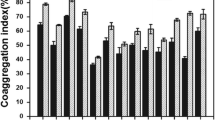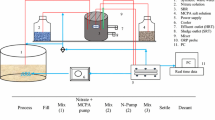Abstract
The internal loop photobiodegradation reactor (ILPBR) was evaluated for the degradation of the pharmaceutical sulfamethoxazole (SMX) using batch experiments following three protocols: photolysis alone (P), biodegradation alone (B), and intimately coupled photolysis and biodegradation (P&B). SMX was removed more rapidly by P&B than by either P or B alone, and the corresponding dissolved organic carbon (DOC) removals by P&B also were higher. The faster SMX removal probably was due to a synergy between photolysis and the rapid biodegradation of SMX by the biofilm. The greater DOC removal was brought about by the presence of biofilm bacteria able to biodegrade photolysis products. Ammonium N released during photolysis of SMX gave more evidence for the formation of intermediates and was enough in P&B experiments to support bioactivity when no other N was supplied. Clone libraries performed on the biofilms before and after the P&B experiments showed profound changes in the microbial community. Whereas Rhodopirellula baltica and Methylibium petroleiphilum PM1 dominated the biofilm after the B experiments, they were replaced by Micrococcus luteus, Delftia acidovorans, and Oligotropha carboxidovorans after the P&B experiments. The changes in microbial community structure mirrored the change in function in the P&B experiments: SMX biodegradation (presumably the roles of R. baltica and M. petroleiphilum) was out-competed by SMX photolysis, but biodegradation of photolysis products (most likely by M. luteus and D. acidovorans) became important. The higher removal rates of SMX and DOC, as well as the changes in microbial community structure, confirm the value of intimately coupling photolysis with biodegradation in the ILPBR.







Similar content being viewed by others
References
Abellán MN, Bayarri B, Giménez J, Costa J (2007) Photocatalytic degradation of sulfamethoxazole in aqueous suspension of TiO2. Appl Catal B: Environ 74(3–4):233–241
Akiyama T, Savin MC (2010) Populations of antibiotic-resistant coliform bacteria change rapidly in a wastewater effluent dominated stream. Sci of the Total Environ 408(24):6192–6201
Alexy R, Kümpel T, Kümmerer K (2004) Assessment of degradation of 18 antibiotics in the Closed Bottle Test. Chemosphere 57(6):505–512
Altschul SF, Gish W, Miller W, Myers EW, Lipman DJ (1990) Basic local alignment search tool. J Mol Biol 215:403–410
Avisar D, Lester Y, Ronen D (2009) Sulfamethoxazole contamination of a deep phreatic aquifer. Sci of the Total Environ 407:4278–4282
Baran W, Sochacka J, Wardas W (2006) Toxicity and biodegradability of sulfonamides and products of their photocatalytic degradation in aqueous solutions. Chemosphere 65:1295–1299
Beltrán FJ, Aguinaco A, García-Araya JF, Oropesa A (2008) Ozone and photocatalytic processes to remove the antibiotic sulfamethoxazole from water. Water Res 42(14):3799–3808
Buser HR, Muller MD, Theobald N (1998a) Occurrence of the pharmaceutical drug clofibric acid and the herbicide mecoprop in various Swiss lakes and in the North Sea. Environ Sci Technol 32(1):188–192
Buser HR, Poiger T, Muller MD (1998b) Occurrence and fate of the pharmaceutical drug diclofenac in surface waters: rapid photodegradation in a lake. Environ Sci Technol 32(22):3449–3456
Buser HR, Poiger T, Müller MD (1999) Occurrence and environmental behavior of the chiral pharmaceutical drug ibuprofen in surface waters and in wastewater. Environ Sci Technol 33(15):2529–2535
Chong MN, Jin B, Chow CWK, Saint C (2010) Recent developments in photocatalytic water treatment technology: a review. Water Res 44(10):2997–3027
Dantas RF, Contreras S, Sans C, Esplugas S (2008) Sulfamethoxazole abatement by means of ozonation. J of Hazardous Mater 150(3):790–794
Eaton RW (1982) Metabolism of dibutylphthalate and phthalate by Micrococcus sp. strain 12B. J Bacteriol 151(1):48–57
Glöckner FO, Kube M, Bauer M, Teeling H, Lombardot T, Ludwig T, Gade D, Beck A, Borzym K, Heitmann K, Rabus R, Schlesner H, Amann R, Reinhardt R (2003) Complete genome sequence of the marine planctomycete Pirelulla sp. strain 1. Proc Natl Acad Sci USA 100(14):8298–8303
Godon JJ, Zumstein E, Dabert P, Habouzit FMR (1997) Molecular microbial diversity in an anaerobic digester as determined by small-subunit r-DNA sequence analysis. Appl Environ Microbiol 63(7):2802–2813
Guha A, Kumari B, Bora TC, Roy MK (1997) Possible involvement of plasmids in degradation of malathion and chlorpyriphos by Micrococcus sp. Folia. Microbiol 42(6):574–576
Hanson JR, Ackerman CE, Scow KM (1999) Biodegradation of methyl tert-butyl ether by a bacterial pure culture. Appl Environ Microbiol 65(11):4788–4792
Heberer T (2002) Tracking persistent pharmaceutical residues from municipal sewage to drinking water. J of Hydrology 266(3–4):175–189
Hirsch R, Ternes T, Haberer K, Kratz KL (1999) Occurrence of antibiotics in the aquatic environment. Sci Total Environ 225:109–118
Hristova KB, Gebreyesus B, Mackay D, Scow KM (2003) Naturally occurring bacteria similar to the methyl tert-butyl ether (MTBE)-degrading strain PM1 are present in MTBE-contaminated groundwater. Appl Environ Microbiol 69(5):2616–2623
Hu L, Flanders PM, Miller PL, Strathmanna TJ (2007) Oxidation of sulfamethoxazole and related antimicrobial agents by TiO2 photocatalysis. Water Res 41(12):2612–2626
Kazuya W, Maki T, Shigeaki H (1999) An outbreak of nonflocculating catabolic populations caused the breakdown of a phenol-digesting activated-sludge process. Appl Environ Microbiol 65(7):2813–2819
Keizer de W, Bienenmann-Ploum ME, Bergwerff AA, Haasnoot W (2008) Flow cytometric immunoassay for sulfonamides in raw milk. Analytica Chimica Acta 620:142–149
Kim I, Tanaka H (2009) Photodegradation characteristics of PPCPs in water with UV treatment. Environ International 35(5):793–802
Kim Y, Choi K, Jung J, Park S, Kim P, Park J (2007) Aquatic toxicity of acetaminophen, carbamazepine, cimetidine, diltiazem and six major sulfonamides, and their potential ecological risks in Korea. Environ International 33:370–375
Kumarasamy KK, Toleman MA, Walsh TR, Bagaria J, Butt F, Balakrishnan R, Chaudhary U, Doumith M, Giske CG, Irfan S, Krishnan P, Kumar AV, Maharjan S, Mushtaq S, Noorie T, Paterson DL, Pearson A, Perry C, Pike R, Rao B, Ray U, Sarma JB, Sharma M, Sheridan E, Thirunarayan MA, Turton J, Upadhyay S, Warner M, Welfare W, Livermore DM, Woodford N (2010) Emergence of a new antibiotic resistance mechanism in India, Pakistan, and the UK: a molecular, biological, and epidemiological study. Lancet Infect Dis 10(9):597–602
Li XY, Gao F, Li ZQ, Guan W, Feng WL, Ge RL (2009) Comparison of the pharmacokinetics of sulfamethoxazole in male Chinese volunteers at low altitude and acute exposure to high altitude versus subjects living chronically at high altitude: an open-label, controlled, prospective study. Clin Therapeut 31(11):2744–2754
Marsolek MD, Torres CI, Hausner M, Rittmann BE (2008) Intimate coupling of photocatalysis and biodegradation in a photocatalytic circulating-bed biofilm reactor. Biotechnol Bioeng 101(1):83–92
Meyer O, Stackebrandt E, Auling G (1993) Reclassification of ubiquinone Q-10 containing carboxidotrophic bacteria: transfer of “[Pseudomonas] carboxydovorans” OM5T to Oligotropha, gen. nov., as Oligotropha carboxidovorans, comb. nov., transfer of “[Alcaligenes] carboxydus” DSM 1086T to Carbophilus, gen. nov., as Carbophilus carboxidus, comb. nov., transfer of “[Pseudomonas] compransoris” DSM 1231T to Zavarzinia, gen. nov., as Zavarzinia compransoris, comb. nov., and amended descriptions of the new genera. Syst Appl Microbiol 16(3):390–395
Muñoza R, Köllnera C, Guieyssea B (2009) Biofilm photobioreactors for the treatment of industrial wastewaters. J of Hazardous Mater 161(1):29–34
Nasuhoglu D, Yargeau V, Berk D (2011) Photo-removal of sulfamethoxazole (SMX) by photolytic and photocatalytic processes in a batch reactor under UV-C radiation (λmax = 254 nm). J of Hazardous Mater 186(1):67–75
Overbye KM, Barrett JF (2005) Antibiotics: where did we go wrong? Drug Discov Today 10(1):45–52
Reddy MP, Srinivas B, Kumari VD, Subrahmanyam M, Sharma PN (2004) An integrated approach of solar photocatalytic and biological treatment of N-containing organic compounds in wastewater. Toxicol and Environ Chem 86(1–4):125–138
Santos LHMLM, Araújo AN, Fachini A, Pena A, Delerue-Matos C, Montenegro MCBSM (2010) Ecotoxicological aspects related to the presence of pharmaceuticals in the aquatic environment. J of Hazardous Mater 175(1–3):45–95
Schulz S, Dong W, Groth U, Cook AM (2000) Enantiomeric degradation of 2-(4-sulfophenyl) butyrate via 4-sulfocatechol in Delftia acidovorans SPB1. Appl Environ Microbiol 66(5):1905–1910
Sengupta N, Alam SI, Kumar RB, Singh L (2011) Diversity and antibiotic susceptibility pattern of cultivable anaerobic bacteria from soil and sewage samples of India. Infect Genet Evol 11(1):64–77
Silva CG, Faria JL (2009) Effect of key operational parameters on the photocatalytic oxidation of phenol by nanocrystalline sol–gel TiO2 under UV irradiation. J of Molecular Catal A: Chem 305(1–2):147–154
Stackelberg PE, Furlong ET, Meyer MT, Zaugg SD, Henderson AK, Reissman DB (2004) Persistence of pharmaceutical compounds and other organic wastewater contaminants in a conventional drinking-water-treatment plant. Sci of the Total Environ 329(1–3):99–113
Suryaman D, Hasegawa K, Kagaya S (2006) Combined biological and photocatalytic treatment for the mineralization of phenol in water. Chemosphere 65(11):2502–2506
Tao R, Ying GG, Su HC, Zhou HW, Sidhu JPS (2010) Detection of antibiotic resistance and tetracycline resistance genes in Enterobacteriaceae isolated from the Pearl rivers in South China. Environ Pollution 158(6):2101–2109
Thiele-Bruhn S, Beck IC (2005) Effects of sulfonamide and tetracycline antibiotics on soil microbial activity and microbial biomass. Chemosphere 59:457–465
Trovó AG, Nogueira RFP, Agüera A, Sirtori C, Fernández-Alba AR (2009) Photodegradation of sulfamethoxazole in various aqueous media: persistence, toxicity and photoproducts assessment. Chemosphere 77(10):1292–1298
Wei F (2002) Monitoring and analytic methods of water and wastewater, 4th edn. Environmental Science Press of China, Beijing
Zhang Y, Marrs CF, Simon C, Xi C (2009) Wastewater treatment contributes to selective increase of antibiotic resistance among Acinetobacter spp. Sci of the Total Environ 407(12):3702–3706
Zhang Y, Wang L, Rittmann BE (2010a) Integrated photocatalytic-biological reactor for accelerated phenol mineralization. Appl Microbiol and Biotechnol 86(6):1977–1985
Zhang Y, Liu H, Shi W, Pu X, Rittmann BE (2010b) Photobiodegradation of phenol with ultraviolet irradiation of new ceramic biofilm carriers. Biodegradation 21(6):881–887
Zhuang WQ, Tay JH, Maszenan AM, Krumholz LR, Tay ST (2003) Importance of Gram-positive naphthalene-degrading bacteria in oil-contaminated tropical marine sediments. Lett Appl Microbiol 36(14):251–257
Zühlke S, Dünnbier U, Heberer T (2004) Detection and identification of phenazone-type drugs and their microbial metabolites in ground and drinking water applying solid-phase extraction and gas chromatography with mass spectrometric detection. J of Chromatography A 1050(2):201–209
Acknowledgments
The authors acknowledge the financial support by the National Natural Science Foundation of China (50978164), the Special Foundation of Chinese Colleges and Universities Doctoral Discipline (20070270003), Innovation Fund for Key Projects of Shanghai Municipal Education Commission (10ZZ82), the Shanghai Leading Academic Discipline Project (S30406), and the United States National Science Foundation (0651794).
Author information
Authors and Affiliations
Corresponding author
Rights and permissions
About this article
Cite this article
Yan, N., Xia, S., Xu, L. et al. Internal loop photobiodegradation reactor (ILPBR) for accelerated degradation of sulfamethoxazole (SMX). Appl Microbiol Biotechnol 94, 527–535 (2012). https://doi.org/10.1007/s00253-011-3742-0
Received:
Revised:
Accepted:
Published:
Issue Date:
DOI: https://doi.org/10.1007/s00253-011-3742-0




